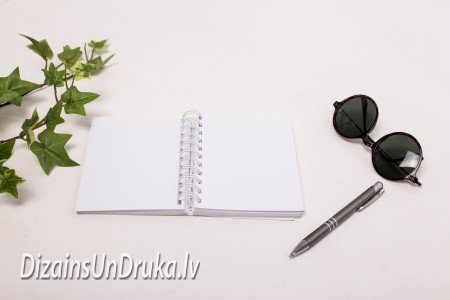Informative about types of binding!

Even though more and more information can be found in the digital world, manual binding is still relevant. There are 4 popular types of binding: hardcover; softcover; spiral binding and stapling. In this article, we will inform you about them, so you can choose the most suitable one for yourself.
1. Hardcover.
In hardcover binding, the book block is glued into cardboard covers, which are covered with a printed cover material (paper, fabric, leather, etc.). Usually, the material is coated with a protective layer that protects it from moisture and dirt. Hardcover options come in various variations, with personalized design, materials, etc. The block may be either glued or stitched with threads, and there are very broad options for thickness.
Our print shop also offers individual book binding in small editions. Book binding by hand is a time-consuming and relatively expensive job, hence it's less demanded. Mostly, this type of book can be used to bind a thesis or an individual book. If you want to create a book to keep for yourself or give as a gift to friends or family, an exclusive hardcover book will make an impressive gift you can be proud of.
2. Softcover.
In softcover binding, the covers are not made from cardboard – the cover is just slightly thicker than the inner pages. This binding can be produced faster, which is considered one of the major advantages of softcover because it allows for large editions to be produced in a short time at lower costs. Softcover is mainly used for binding informational content, presentation materials, and textbooks. Unlike hardcover, this type of book will be lighter in weight.
For gluing, thermal adhesive is used, which is heated during the binding process and strongly secures the pages together. For stronger adhesive bonding, our machine mills the block of pages. The block is glued into the cover and left to cool and set before trimming to the desired dimensions.
Softcover is usually glued – stitching with threads is rare, especially if the edition is larger than, say, 5 copies. Stitching with threads is recommended if the block is meant to be thick, since regularly flipping through a thick book, the glued pages might separate.
3. Spiral binding.
The use of metal or plastic coils is the fastest way to reinforce the binding, moreover, the thickness of the block can be very varied – coils of different sizes are available. Such a bound block is very convenient to use, as the pages can be turned 360 degrees. For extra protection and finishing, you can choose plastic covers, and also have the printed cover laminated.
This way is convenient for binding instructions, various handouts, documents, etc.
4. Stapled binding.
Stapled or brochure-type binding is intended for brochures with a small number of pages. The book/brochure block, with or without a cover, is stapled with 1–3 staples and trimmed. This type of binding is economical and environmentally friendly. This method can be used for educational and instructional materials, notebooks, thin brochures, etc. Production (depending on the material and thickness of the pages) is simple and quick.
Stapling is possible in 2 types: notebook type and block type, when the block is stapled in a flat way.
The company Dizains un Druka offers all four types of binding. Choose the most convenient and suitable for you, and we will consult you about design, materials, and printing possibilities.
